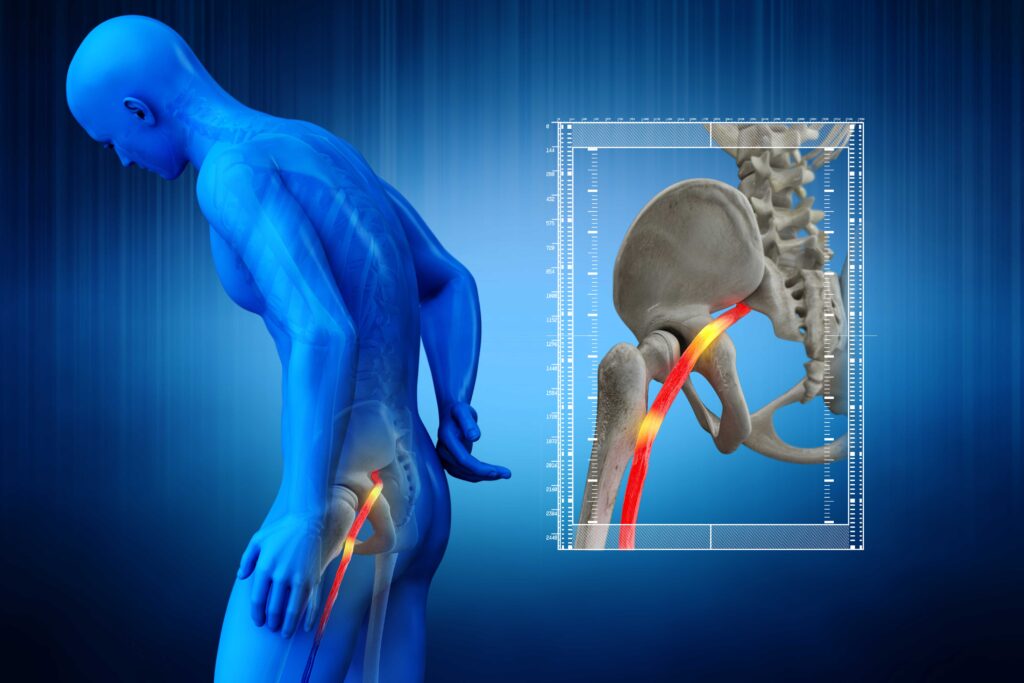How to Achieve Sciatic Nerve Pain Relief?
Sciatic nerve pain can be debilitating and prevent you from doing everyday activities, including simple activities like sitting on the couch.
It’s caused by irritation, inflammation, or pinching of a nerve in your lower back.
Most people get better on their own with time and self-care treatments, but for some, they need more intense methods to find sciatica pain relief.
Keep reading to learn about five different methods for sciatica pain treatments and get on the path to feeling great again.
What is your sciatic nerve?
The sciatic nerve is the thickest and longest nerve in the body. It is about a finger-width thick.
It’s made up of five different nerve roots: two in the lumbar region of the lower back and three in the sacrum.
The five nerve roots form a right and left sciatic nerve; on each side of your body, the sciatic nerve runs down through your hips, buttocks, and leg, ending just below the knee.
True injury to the sciatic nerve, called ‘sciatica,’ is rare. Still, the term can also describe any pain that originates in the lower back and radiates through the hips and down one leg.
It can cause weakness, numbness, or tingling in your leg, foot, and toes.
Sciatica symptoms
Common symptoms of sciatic nerve pain include:
-
-
- Moderate to severe pain in your lower back, buttocks, and down one leg
- Numbness or weakness in your lower back, buttock, leg, or feet
- Pain that worsens with movement or loss of movement.
- Tingling in your legs, toes or feet.
-
Sciatic nerve pain treatments
Sciatica is different for every person. The type, intensity, and cause of pain vary in every patient.
For most people, a conservative treatment done at home can cause relief, but for some, aggressive sciatica treatment may be needed to resolve the issues.
If you have not found relief from your symptoms after a few weeks of self-care, it may be time to see a licensed healthcare professional to try other treatment options.
Self-care
Fortunately for most, sciatica responds to self-care measures at home.
Resting at home for a day or so may provide some relief, be careful because prolonged inactivity can weaken the muscles and make the signs and symptoms of your sciatic nerve pain worse.
Self-care treatments that might help include:
-
-
- Cold packs – You may find relief from a cold pack placed on the area of pain for up to twenty minutes a session, several times a day. Use an ice pack, bag of ice, or frozen peas wrapped in a towel to treat your sciatica and reduce pain and swelling.
- Hot packs – After two to three days of cold packs, switch to hot packs and apply heat to the areas that hurt. Use a heating pad, hot pack, or heat lamp. If you continue to have pain, you can try alternating warm and cold packs.
- Over-the-counter medication – Common pain relievers known as non-steroidal anti-inflammatory drugs (NSAIDs) such as ibuprofen, naproxen sodium, or aspirin can be helpful for sciatica. They help reduce pain, inflammation, and swelling. When taking aspirin, be careful with the amount you take. Aspirin can cause ulcers and bleeding in some individuals. If you cannot take NSAIDs, you can take acetaminophen instead.
-
Stretch
Stretches for your lower back (especially ones that externally rotate the hip) can be one of the most beneficial treatments for your sciatica. It can help you feel better while lessening the nerve root compression that is causing you pain.
Be sure to avoid jerking, bouncing or twisting while stretching, and try to hold the stretch for at least 30 seconds.
Six exercises to try at home to relieve pain:
-
-
- Reclining pigeon pose
- Sitting pigeon pose
- Forward pigeon pose
- Knee to the opposite shoulder
- Sitting spinal stretch
- Standing hamstring stretch
-
Prescription medication
If over-the-counter medication is not working for you, your healthcare provider may prescribe muscle relaxers.
Muscle relaxers such as cyclobenzaprine relieve comfort from the muscle spasms causing you pain.
Other less commonly used medications with pain-relieving properties can be prescribed, including tricyclic antidepressants and anti-seizure medications.
Depending on your severity of pain, you may need to use prescription pain medications early in your treatment plan.

